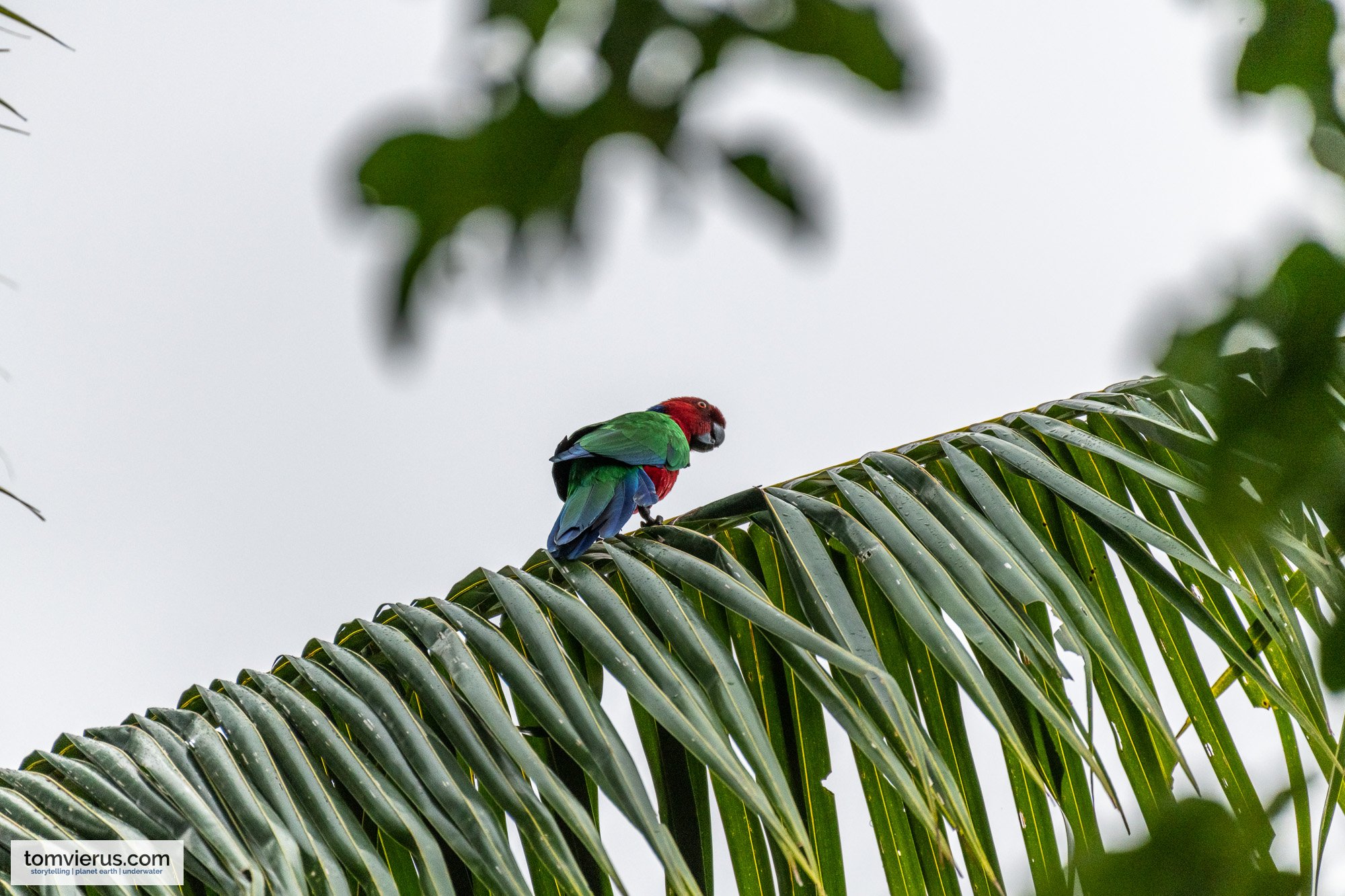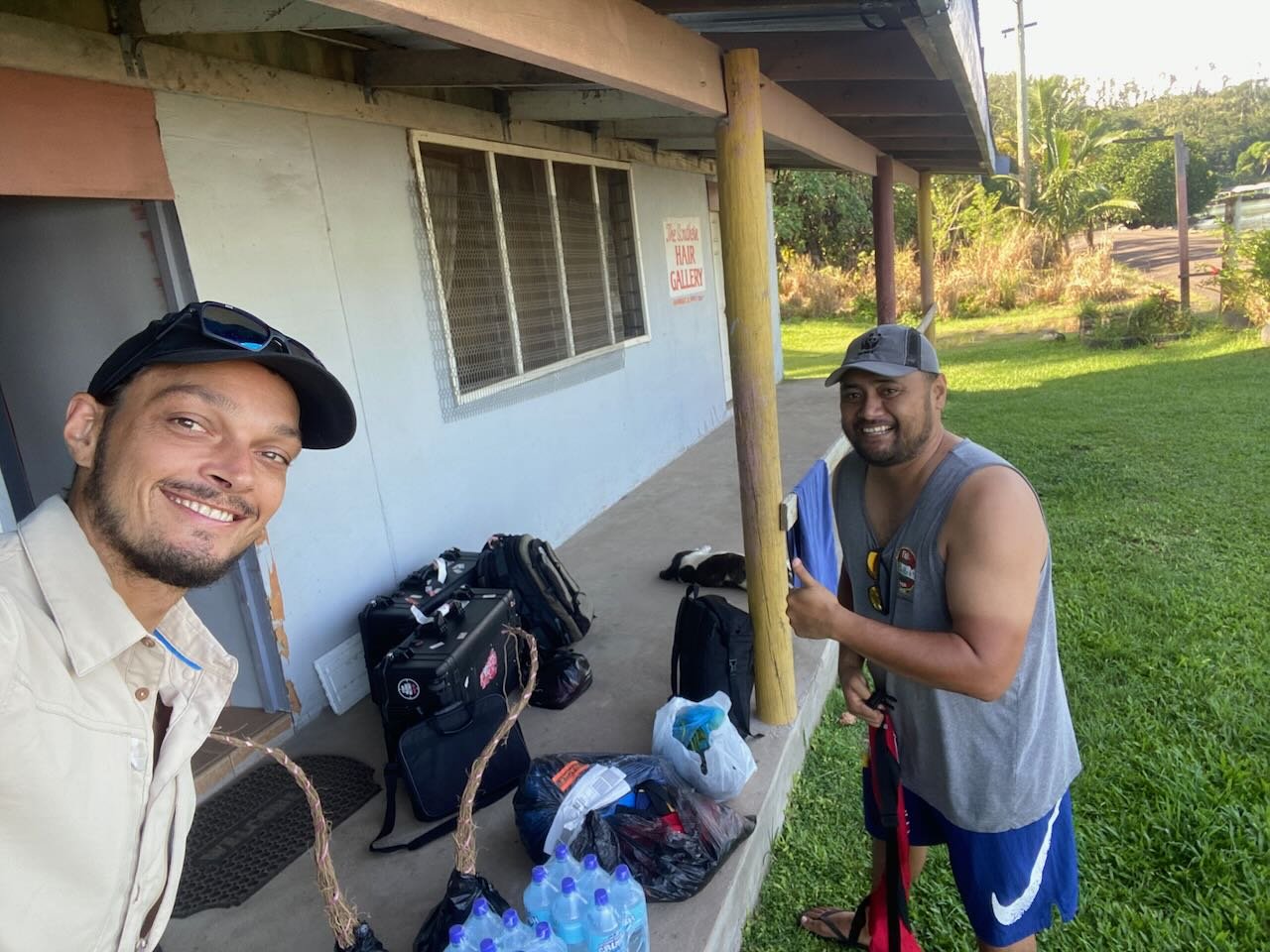WWF Turtle Monitoring around Dravuni Island in Fiji
The Fiji Airways Twin Otter plane that took us to Vunisea, Kadavu.
Our little hostel for the first night.
After two very short days in Suva, Ravai and I met again Sunday morning to fly to Vunisea in Kadavu, where we would continue our journey to our last destination: Dravuni Island. There are no direct flights to Kadavu from Suva, so we stopped at Nadi, worked during the waiting time at the airport, and then caught the small Fiji Airways plane to Vunisea. I have been to some smaller islands around Kadavu but never to Kadavu itself, and I was really looking forward to it.
After a short flight in a small Twin Otter that we shared with four other people, we touched down on the picturesque landing strip in the tiny town of Vunisea. It lies around a bay surrounded by the lush mountainous landscape of Kadavu, Fiji's fourth-largest island. From here, we would take fibreglass for another 2 hours to Dravuni Island, located at the most northern tip of the Kadavu Island chain. But not before the following day.
A quick birding tour in Vunisea, Kadavu
A Black-shouldered Lapwing (Vanellus miles ssp. novaehollandiae) photographed in Vunisea, Kadavu, Fiji.
A Crimson Shining-Parrot (Prosopeia splendens) perches on a palm tree leaf near Vunisea on Kadavu island. This parrot is endemic to Fiji and classified as Vulnerable by the International Union for Conservation of Nature (IUCN). Originally, it only appeared on Kadavu and Ono Island and is also referred to as the Kadavu Musk Parrot. Fiji, South Pacific.
We made our way to the little bed and breakfast and, after checking in, spent the rest of the day planning the upcoming shoot, organising kava and other supplies, taking a walk along the shore and, as usual, trying to photograph the local bird life. Ravai came with me on the briding walk to spot the local bird life, and just like me, I think he really enjoyed it! I really wish that Fiji's tourism industry would get a bit more into bird watching here - or maybe this is something I should offer? It was great shooting a few images, albeit not award-winning shots, of the Kadavu Honeyeater (which I hadn't photographed before and which is now in my Manumanu Vuka collection) as well as, to my surprise, the black-shouldered lapwing! I totally did not expect that bird here, and in fact, I wasn't even aware it could be found in Fiji! Years ago, I photographed these birds in Australia, where they are pretty common. A quick iNaturalist search (if you don't know what this is, check it out and create an account!) showed this bird was photographed and uploaded from Fiji exactly one time: at the same exact spot almost seven years ago!
From Vunisea to Dravuni Island
Ready to head to Dravuni Island.
Aerial view of Dravuni Island in the Ono District, Kadavu Province, Fiji.
Resting and eating on Ratu Viliame’s porch.
A team of WWF turtle monitor volunteers led patrols a Daveta Beach, a nesting site for turtles on Vanuakula Island, a small island near Kadavu in Fiji.
The next morning, we met our captain, who would take us to the next and last location of this WWF shoot: Dravuni Island, where another group of volunteers had just spent a month patrolling and monitoring nearby islands known to serve as turtle nesting sites. When we approached Dravuni, I realised I had already been to the island. A few years ago, during a Captain Cook Cruise trip to the Lau Islands Group, we made a stop here on our way back to Viti Levu, hiked the island's only hill and continued our tour towards Suva. Back then, the world was still in the middle of COVID life, and thus, we weren't allowed to interact with the island community. Great to come back here and do just that. Dravuni Island itself is absolutely stunning. It is a rather thin, elongated island with magnificent white sand beaches. Basically, the typical postcard you would see from the South Pacific.
There is one village on Dravuni Island, and I must admit it is probably the most beautiful village I have been to in Fiji. The houses are well maintained; the ground is covered in extremely comfortable carpet grass (fun fact: apparently, many years ago, one of the community members brought a small patch of this grass from Viti Levu, and it has since grown so much that it basically covers the entire ground in the village). Everything is just very well taken care of. After meeting the volunteers and relaxing in the village headman's house for a while, we conducted the traditional sevusevu ceremony at the Chief's house to obtain the necessary allowances for our endeavour. Once that was done, we prepared the gear and started heading out.
Similarly to the other two locations, the volunteers here had monitored several nearby islands over the past month to document any and all turtle-related activity. The first island we visited was Vanuakula Island, more specifically, Daveta Beach, where several nests were already recorded. I followed the group doing their normal activity and took photos and videos, switching between my two cameras, the Nikon D850 and the Nikon D810. At the other two previous locations, Kavewa Island and Yadua Taba Island, the volunteers had only documented hawksbill turtle nests, whereas interestingly, here on Vanuakula Island, they had also discovered one green turtle nest.
You might ask how they know (at least that was my question), and in fact, it is quite simple to differentiate between the two. First of all, the green turtle eggs are considerably larger than their relative's eggs, and secondly, the nests are dug much deeper. This particular one was about 60-80cm deep in the sand. Just think about the turtle digging a hole like that using her flippers -what an incredible task![pt_view id="f292f89u3p"]
Island hopping from Dravuni Island in northern Kadavu
Aerial view of Qasibale Island, a known turtle nesting site in Ono District, Kadavu Province, Fiji.
A moment of relaxation back on Dravuni with a fresh coconut. Sometimes it is really the simple things in life that create happiness. Photo by Ravai Vafo’ou.
The drone sparks interest wherever she goes 🙂 Photo by Ravai .Vafo’ou
Over the next hours, we went from island to island, shot all the needed video and photo content, and thoroughly documented all sights for future purposes. In total, we visited four islands: Vanuakula, Namara, Qasibale and Yakuvewaswa Island. All of them had several nests, so there were literally thousands of turtle hatchlings waiting to make their first moves in life. As the afternoon went on, we finished our monitoring patrol and headed back to Dravuni Island, where we cooled off in the South Pacific waters with another million-dollar view. The orange light of the setting sun, the beautiful beach, the happy community members and the action-packed day - it just all came together and created a beautiful moment. I felt incredibly blessed again to be where I was and doing what I love.
Catching a green turtle
The drone was crucial in helping us find turtles from above. Photo by Ravai Vafo’ou.
Ratu Viliame Tuinavadra with a green turtle (Chelonia mydas) that he captured during freediving. After a few measurements, the turtle was released back into the waters surrounding Dravuni Island, Ono District, Fiji. Green turtles are classified as ‘Endangered’ by the International Union for Conservation of Nature (IUCN).
Taking photos of the action from the water. Photo by Ravai Vafo’ou.
WWF turtle monitor volunteers measure a green turtle (Chelonia mydas) captured near Dravuni Island, Kadavu Province, Fiji. After the measurements, the green turtle is released back into the water. Green turtles are classified as ‘Endangered’ by the International Union for Conservation of Nature (IUCN). From left to right: Ratu Viliame Tuinavadra (holding the turtle in the water) Vanivasa Vone, Theresa Kafka, Lynn Vuli, Mikaele Finau.
WWF turtle monitor volunteers measure a green turtle (Chelonia mydas) captured near Dravuni Island, Kadavu Province, Fiji. After the measurements, the green turtle is released back into the water. Green turtles are classified as ‘Endangered’ by the International Union for Conservation of Nature (IUCN). From left to right: Vanivasa Vone, Lynn Vuli, Mikaele Finau.
On the following day, we planned to shoot a capture of a turtle near Dravuni Island in order to get some measurements before releasing it back into its habitat. Ratu Viliame Tuinavadra was happy to show off his skills. Unlike the "ordinary" turtle-catching technique of jumping right on top of the turtle from a boat, grabbing the sides of the carapace and turning it around, his method just involved freediving and catching the turtle underwater. Honestly, I didn't believe it would work. We scouted the waters surrounding Dravuni for probably nearly an hour before we found a few turtles in 10-20 m depth. Ratu and I jumped in the water while the rest of the crew stayed in the boat.
Ratu Viliame's first approach was in vain; the turtle saw him coming and easily outswam him underwater. However, back at the surface, he showed me another individual resting on the seafloor at maybe 15m depth. The good thing for Ratu was that there was a little stony outcrop which would allow him to snug up from behind. Indeed, he dove down, slowly approached the turtle while taking cover behind the stone, and then grabbed it with a decisive move. When I watched both of them coming up towards the surface, I could hardly believe what I just witnessed and was pretty impressed! The boat came closer, and the volunteers were able to conduct a few measurements and record the data before we released the turtle again. We didn't want to cause her too much stress, but it was a great opportunity to document how the villagers here caught turtles with their bare hands.
Heading back to Suva
Early morning arrival in Suva.
A green sea turtle (Chelonia mydas) cruises along the shallow coastal waters surrounding Yakuvewaswa Island. Green sea turtles are classified as as ‘Endangered’ by the International Union for Conservation of Nature (IUCN).
All things come to an end, and so did our time in the field documenting WWF-Pacific's turtle monitor project. It was a hard and draining but, at the same time, fantastic time in the field, and I would like to highlight Ravai's work and efforts again. Without his organisation, planning, facilitation and soft skills, this assignment would not have been possible. I do hope we get to work again in future! We retired early that night to get a head start the following morning. The plan was to leave Dravuni at about 4:30 am on a fibre towards Suva. The journey would take us about two hours, most of it in complete darkness. Our captain, Ratu Viliame's brother, had done these trips dozens, if not hundreds of times and knew his way. The early start also helped to avoid rough sea conditions, as early mornings are usually the calmest.
Indeed, we rose just before four in the morning, carried all the camera gear, as well as any equipment and luggage the volunteers had with them, to the boat and started the long ride. When the sun slowly rose a few hours later, and we could already see Suva's skyline in the distance, it was again one of these wonderful moments of just being in the present moment. The morning glow, the flat glass-like ocean, the wind .. it just made me feel good, and I had a moment of accomplishment and was happy and proud of what we had achieved over the last few days. Until the next time, dear Panda!For more information on WWF Pacific's Volunteer programme, head to their page www.wwfpacific.org
Have you subscribed to my newsletter yet? I am sending out 1-2 emails monthly to share some behind-the-scenes stories and photos of my projects and assignments here in the Pacific.




















